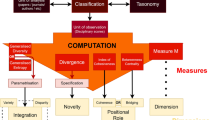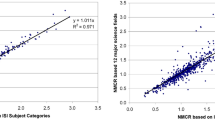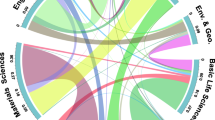Abstract
Macro-level domains of the science system, usually referred to as STM and SSH disciplines, have often been contrasted from various perspectives, regarding the characteristic composition of their publication channels, referencing or communication practices, and the related consequences in research evaluation. It is also long been conjectured that social science fields (along with the humanities) are more multidisciplinary than natural science fields, regarding their patterns of scholarly communication (“multidisciplinarity thesis”). The main goal of the study reported in this paper is twofold: (1) to revisit the differences in multidisciplinarity between the SSH versus STM domain, via a long-term longitudinal survey including the most recent trends, and (2) to utilize, for this task, state-of-the-art metrics and models of Interdisciplinary Research, taking into account their limitations, that is, the data sources that most naturally feed these models (typically the Web of Science). Our conclusions provides further confirmation, from the perspective of multidisciplinarity, that the concepts of SSH and STM are mainly tools for communication, rather than empirically valid constructs.






Similar content being viewed by others
References
Archambault, É., Vignola-Gagné, É., Côté, G., Larivière, V., & Gingrasb, Y. (2006). Benchmarking scientific output in the social sciences and humanities: The limits of existing databases. Scientometrics, 68(3), 329–342.
Garner, J., Porter, A. L., Borrego, M., Tran, E., & Teutonico, R. (2013). Facilitating social and natural science cross-disciplinarity: Assessing the human and social dynamics program. Research Evaluation, 22(2), 134–144.
Gingras, Y., & Larivière, V. (2010). The historical evolution of interdisciplinarity: 1900–2008. In 11th International conference on science and technology indicators (p. 100).
Glänzel, W., & Schoepflin, U. (1999). A bibliometric study of reference literature in the sciences and social sciences. Information Processing and Management, 35, 31–44.
Gough, I. (2001). Social assistance regimes: a cluster analysis. Journal of European social policy, 11(2), 165–170.
Harzing, A. W. (2013). Document categories in the ISI Web of Knowledge: Misunderstanding the social sciences? Scientometrics, 94(1), 23–34.
Hicks, D. (1999). The difficulty of achieving full coverage of international social science literature and the bibliometric consequences. Scientometrics, 44(2), 193–215.
Hicks, D. (2004). The four literatures of social science. Handbook of quantitative science and technology research (pp. 473-496).
Hicks, D. (2006). The dangers of partial bibliometric evaluation in the social sciences. Economia politica, 23(2), 145–162.
Huutoniemi, K., Rafols, I. (2017-03-06). Interdisciplinarity in Research Evaluation. Oxford Handbooks Online. Retrieved 14 May 2017.
Larivière, V., Archambault, É., Gingras, Y., & Vignola-Gagné, É. (2006). The place of serials in referencing practices: Comparing natural sciences and engineering with social sciences and humanities. Journal of the American Society for Information Science and Technology, 57(8), 997–1004.
Levitt, J. M., Thelwall, M., & Oppenheim, C. (2011). Variations between subjects in the extent to which the social sciences have become more interdisciplinary. Journal of the Association for Information Science and Technology, 62(6), 1118–1129.
Leydesdorff, L., & Rafols, I. (2011). Indicators of the interdisciplinarity of journals: Diversity, centrality, and citations. Journal of Informetrics, 5(1), 87–100.
Leydesdorff, L., Rafols, I., & Chen, C. (2013). Interactive overlays of journals and the measurement of interdisciplinarity on the basis of aggregated journal–journal citations. Journal of the Association for Information Science and Technology, 64(12), 2573–2586.
Nederhof, A. J. (2006). Bibliometric monitoring of research performance in the Social Sciences and the Humanities: A review. Scientometrics, 66(1), 81–100.
Porter, A. L., Cohen, A. S., Roessner, J. D., & Perreault, M. (2007). Measuring researcher interdisciplinarity. Scientometrics, 72(1), 117–147.
Porter, A., & Rafols, I. (2009). Is science becoming more interdisciplinary? Measuring and mapping six research fields over time. Scientometrics, 81(3), 719–745.
Rafols, I., Leydesdorff, L., O’Hare, A., Nightingale, P., & Stirling, A. (2012a). How journal rankings can suppress interdisciplinary research: A comparison between innovation studies and business & management. Research Policy, 41(7), 1262–1282.
Rafols, I., Leydesdorff, L., O’Hare, A., Nightingale, P., & Stirling, A. (2012b). How journal rankings can suppress interdisciplinary research: A comparison between innovation studies and business & management. Research Policy, 41(7), 1262–1282.
Rafols, I., Porter, A. L., & Leydesdorff, L. (2010). Science overlay maps: A new tool for research policy and library management. Journal of the American Society for Information Science and Technology, 61(9), 1871–1887.
Rogerson, P. (2001). Statistical methods for geography. Thousand Oaks: Sage.
Small, H., & Crane, D. (1979). Specialties and disciplines in science and social science: An examination of their structure using citation indexes. Scientometrics, 1(5–6), 445–461.
Soós, S., & Kampis, G. (2011). Towards a typology of research performance diversity: the case of top Hungarian players. Scientometrics, 87(2), 357–371.
Soós, S., & Kampis, G. (2012). Beyond the basemap of science: mapping multiple structures in research portfolios: evidence from Hungary. Scientometrics, 93(3), 869–891.
Stirling, A. (2007). A general framework for analysing diversity in science, technology and society. Journal of the Royal Society, Interface, 4(15), 707–719.
Wagner, C. S., Roessner, J. D., Bobb, K., Klein, J. T., Boyack, K. W., Keyton, J., et al. (2011). Approaches to understanding and measuring interdisciplinary scientific research (IDR): A review of the literature. Journal of Informetrics, 5(1), 14–26.
Wang, J., Thijs, B., & Glänzel, W. (2015). Interdisciplinarity and impact: distinct effects of variety, balance, and disparity. PLoS One, 10(5), e0127298.
Yegros-Yegros, A., Rafols, I., & D’Este, P. (2015). Does interdisciplinary research lead to higher citation impact? The different effect of proximal and distal interdisciplinarity. PLoS One, 10(8), e0135095.
Acknowledgements
This work was supported by the European Commission under the FP7 Grant No. 613202 (IMPACT-EV project).
Author information
Authors and Affiliations
Corresponding author
Rights and permissions
About this article
Cite this article
Soós, S., Vida, Z. & Schubert, A. Long-term trends in the multidisciplinarity of some typical natural and social sciences, and its implications on the SSH versus STM distinction. Scientometrics 114, 795–822 (2018). https://doi.org/10.1007/s11192-017-2589-2
Received:
Published:
Issue Date:
DOI: https://doi.org/10.1007/s11192-017-2589-2



















